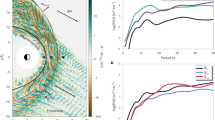Abstract
In this paper, we consider the processes associated with the formation of a so-called foreshock region ahead of the front of a near-Earth collisionless shock wave. In the proposed theoretical model, ions in the ramp or the front of the shock wave are shown to be accelerated to significant energies. The physical conditions under which these ions accelerated in the shock front end up in front of the shock front and move away from it, as a result of which they are sometimes referred to the category of reflected ions, are found. It is concluded that this population of reflected energetic ions (they are most often called “longitudinal beams” or field-aligned beams) plays the main role in the formation of the ion foreshock boundary. The main properties of the longitudinal beams that follow from the considered model are compared with observational data obtained from a spacecraft.




Similar content being viewed by others
REFERENCES
Balogh, A. and Treumann, R.A., Physics of Collisionless Shocks, New York: Springer, 2013. https://doi.org/10.1007/978-1-4614-6099-2
Bol’shakova, O.V. and Troitskaya, V.A., Relation of the interplanetary magnetic field direction to the system of stable oscillations, Dokl. Akad. Nauk SSSR, 1968, vol. 180, no. 2, pp. 343–346.
Bol’shakova, O.V., Troitskaya, V.A., and Rusakova, T.B., Control of Pc3 pulsations in the solar wind and on the Earth by the interplanetary magnetic field, Geomagn. Aeron. (Engl. Transl.), 1987, vol. 27, no. 2, pp. 345–346.
Bonifazi, C. and Moreno, G., Reflected and diffuse ions backstreaming from the Earth’s bow shock 1. Basic properties, J. Geophys. Res., 1981a, vol. 86, pp. 4397–4404.
Bonifazi, C. and Moreno, G., Reflected and diffuse ions backstreaming from the Earth’s bow shock 2. Origin, J. Geophys. Res., 1981b, vol. 86, pp. 4405–4412.
Burgess, D., Möbius, E., and Scholer, M., Ion acceleration at the Earth’s bow shock, Space Sci. Rev., 2012, vol. 173, pp. 5–47. https://doi.org/10.1007/s11214-012-9901-5
Crooker, N.U., Eastman, T.E., Frank, L.A., Smith, E.J., and Russel, C.T., Energetic magnetosheath ions and the interplanetary magnetic field orientation, J. Geophys. Res., 1981, vol. 86, no. A6, pp. 4455–4460.
Eastwood, J.P., Lucek, E.A., Mazelle, C., Meziane, K., Narita, Y., Pickett, J., and Treumann, R.A., Foreshock, Space Sci. Rev., 2005, vol. 118, pp. 41–94. https://doi.org/10.1007/s11214-005-3824-3
Guglielmi, A.V., Diagnostics of the magnetosphere and interplanetary medium by means of pulsations, Space Sci. Rev., 1974, vol. 16, pp. 331–345.
Kichigin, G.N., On the origin of energetic particles in the foreshock region of the Earth’s bow shock, Astron. Lett., 2009, vol. 35, no. 4, pp. 261–269.
Kichigin, G.N., Ion dynamics in magnetosonic shocks front, Soln.-Zemnaya Fiz., 2018, vol. 4, no. 4, pp. 23–31. https://doi.org/10.12737/szf-44201803
Kis, A., Scholer, M., Klecker, B., Kucharek, H., Lucek, E.A., and Rème, H., Scattering of field-aligned beam ions upstream of Earth’s bow shock, Ann. Geophys., 2007, vol. 25, no. 3, pp. 785–799. https://www.ann-geophys.net/25/785/2007.
Oka, M., Terasawa, T., Saito, Y., and Mukai, T., Field-aligned beam observations at the quasi-perpendicular bow shock: Generation and shock angle dependence, J. Geophys. Res., 2005, vol. 110, A05101. https://doi.org/10.1029/2004JA010688
Paschmann, G., Sckopke, I., Papamastorakis, J., Asbridge, J.R., Bame, S.J., and Gosling, J.T., Characteristics of reflected and diffuse ions upstream from the Earth’s bow shock, J. Geophys. Res., 1981, vol. 86, pp. 4355–4364. https://doi.org/10.1029/JA086iA06p0435
Potapov, A.S., Excitation of Pc3 geomagnetic pulsations in front of the Earth’s bow shock by a reflected protons beam, Issled. Geomagn. Aeron. Fiz. Solntsa, 1974, vol. 34, pp. 3–12.
Potapov, A.S., Polyushkina, T.N., and Guglielmi, A.V., Troitskaya–Bolshakova effect as a manifestation of the solar wind wave turbulence, Planet. Space Sci., 2018, vol. 151, pp. 78–84.
7. ACKNOWLEDGMENTS
The author thanks V.G. Eselevich for the attention to this work and useful discussions. The author is especially grateful to the reviewer for the very helpful comments.
Funding
This work was supported within the framework of the Basic Research Program, II.16.
Author information
Authors and Affiliations
Corresponding author
Additional information
Translated by A. Ivanov
Rights and permissions
About this article
Cite this article
Kichigin, G.N. Ionic Foreshock of a Near-Earth Shock Wave: Theoretical Model and Observational Data. Geomagn. Aeron. 61, 325–330 (2021). https://doi.org/10.1134/S0016793221030075
Received:
Revised:
Accepted:
Published:
Issue Date:
DOI: https://doi.org/10.1134/S0016793221030075




